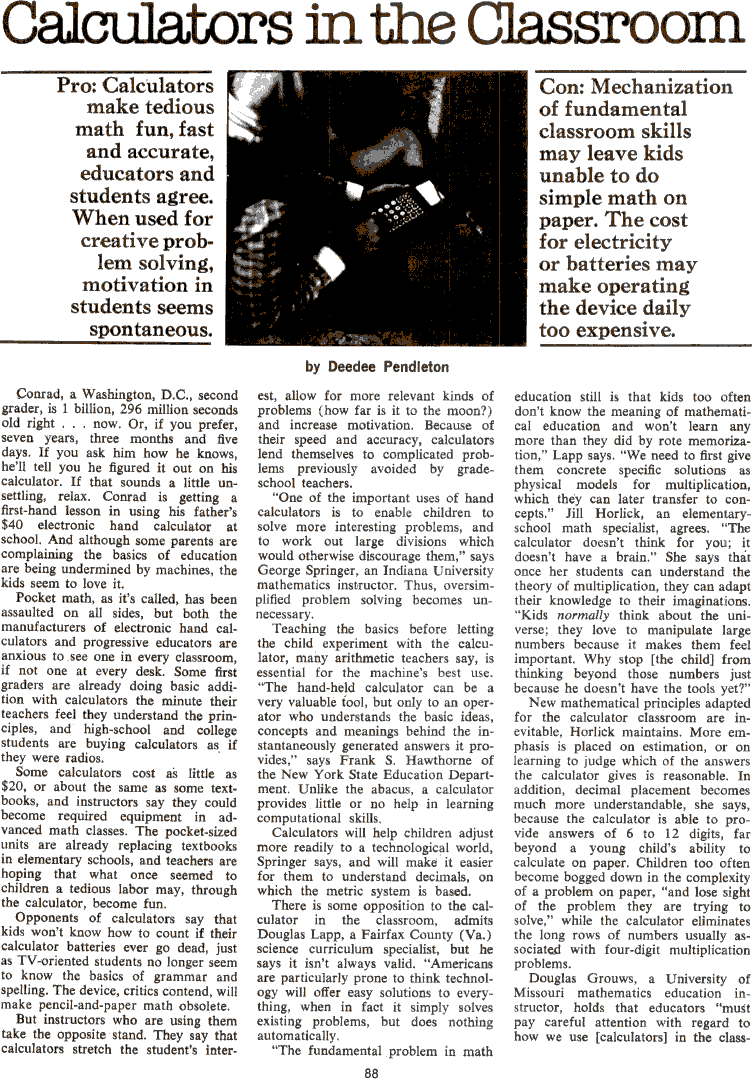by Deedee Pendleton

Calculators in the Classroom by Deedee Pendleton Pro: Calculators make tedious math fun, fast and accurate, educators and students agree. When used for creative problem solving, motivation in students seems spontaneous. Con: Mechanization of fundamental classroom skills may leave kids unable to do simple math on paper. The cost for electricity or batteries may make operating the device daily too expensive. Conrad, a Washington, D.C., second grader, is 1 billion, 296 million seconds old right . . . now. Or, if you prefer, seven years, three months and five days. If you ask him how he knows, he'll tell you he figured it out on his calculator. If that sounds a little unsettling, relax. Conrad is getting a first-hand lesson in using his father's $40 electronic hand calculator at school. And although some parents are complaining the basics of education are being undermined by machines, the kids seem to love it. Pocket math, as it's called, has been assaulted on all sides, but both the manufacturers of electronic hand calculators and progressive educators are anxious to see one in every classroom, if not one at every desk. Some first graders are already doing basic addition with calculators the minute their teachers feel they understand the principles, and high-school and college students are buying calculators as if they were radios. Some calculators cost as little as $20, or about the same as some textbooks, and instructors say they could become required equipment in advanced math classes. The pocket-sized units are already replacing textbooks in elementary schools, and teachers are hoping that what once seemed to children a tedious labor may, through the calculator, become fun. Opponents of calculators say that kids won't know how to count if their calculator batteries ever go dead, just as TV-oriented students no longer seem to know the basics of grammar and spelling. The device, critics contend, will make pencil-and-paper math obsolete. But instructors who are using them take the opposite stand. They say that calculators stretch the student's interest, allow for more relevant kinds of problems (how far is it to the moon?) and increase motivation. Because of their speed and accuracy, calculators lend themselves to complicated problems previously avoided by gradeschool teachers. "One of the important uses of hand calculators is to enable children to solve more interesting problems, and to work out large divisions which would otherwise discourage them," says George Springer, an Indiana University mathematics instructor. Thus, oversimplified problem solving becomes unnecessary. Teaching the basics before letting the child experiment with the calculator, many arithmetic teachers say, is essential for the machine's best use. "The hand-held calculator can be a very valuable tool, but only to an operator who understands the basic ideas, concepts and meanings behind the instantaneously generated answers it provides," says Frank S. Hawthorne of the New York State Education Department. Unlike the abacus, a calculator provides little or no help in learning computational skills. Calculators will help children adjust more readily to a technological world, Springer says, and will make it easier for them to understand decimals, on which the metric system is based. There is some opposition to the calculator in the classroom, admits Douglas Lapp, a Fairfax County (Va.) science curriculum specialist, but he says it isn't always valid. "Americans are particularly prone to think technology will offer easy solutions to everything, when in fact it simply solves existing problems, but does nothing automatically. "The fundamental problem in math education still is that kids too often don't know the meaning of mathematical education and won't learn any more than they did by rote memorization," Lapp says. "We need to first give them concrete specific solutions as physical models for multiplication, which they can later transfer to concepts." Jill Horlick, an elementaryschool math specialist, agrees. "The calculator doesn't think for you; it doesn't have a brain." She says that once her students can understand the theory of multiplication, they can adapt their knowledge to their imaginations. "Kids normally think about the universe; they love to manipulate large numbers because it makes them feel important. Why stop [the child] from thinking beyond those numbers just because he doesn't have the tools yet?" New mathematical principles adapted for the calculator classroom are inevitable, Horlick maintains. More emphasis is placed on estimation, or on learning to judge which of the answers the calculator gives is reasonable. In addition, decimal placement becomes much more understandable, she says, because the calculator is able to provide answers of 6 to 12 digits, far beyond a young child's ability to calculate on paper. Children too often become bogged down in the complexity of a problem on paper, "and lose sight of the problem they are trying to solve," while the calculator eliminates the long rows of numbers usually associated with four-digit multiplication problems. Douglas Grouws, a University of Missouri mathematics education instructor, holds that educators "must pay careful attention with regard to how we use [calculators] in the class

